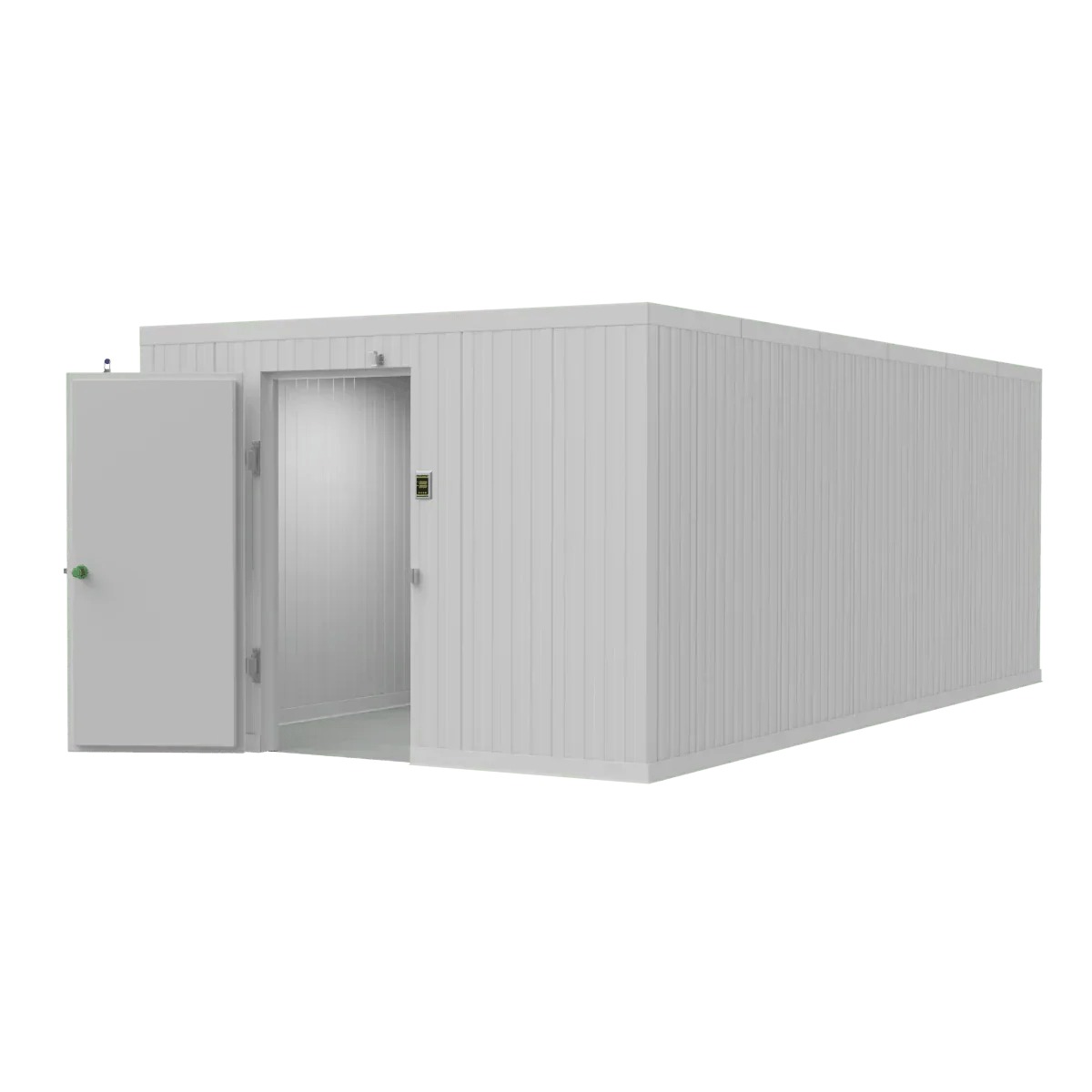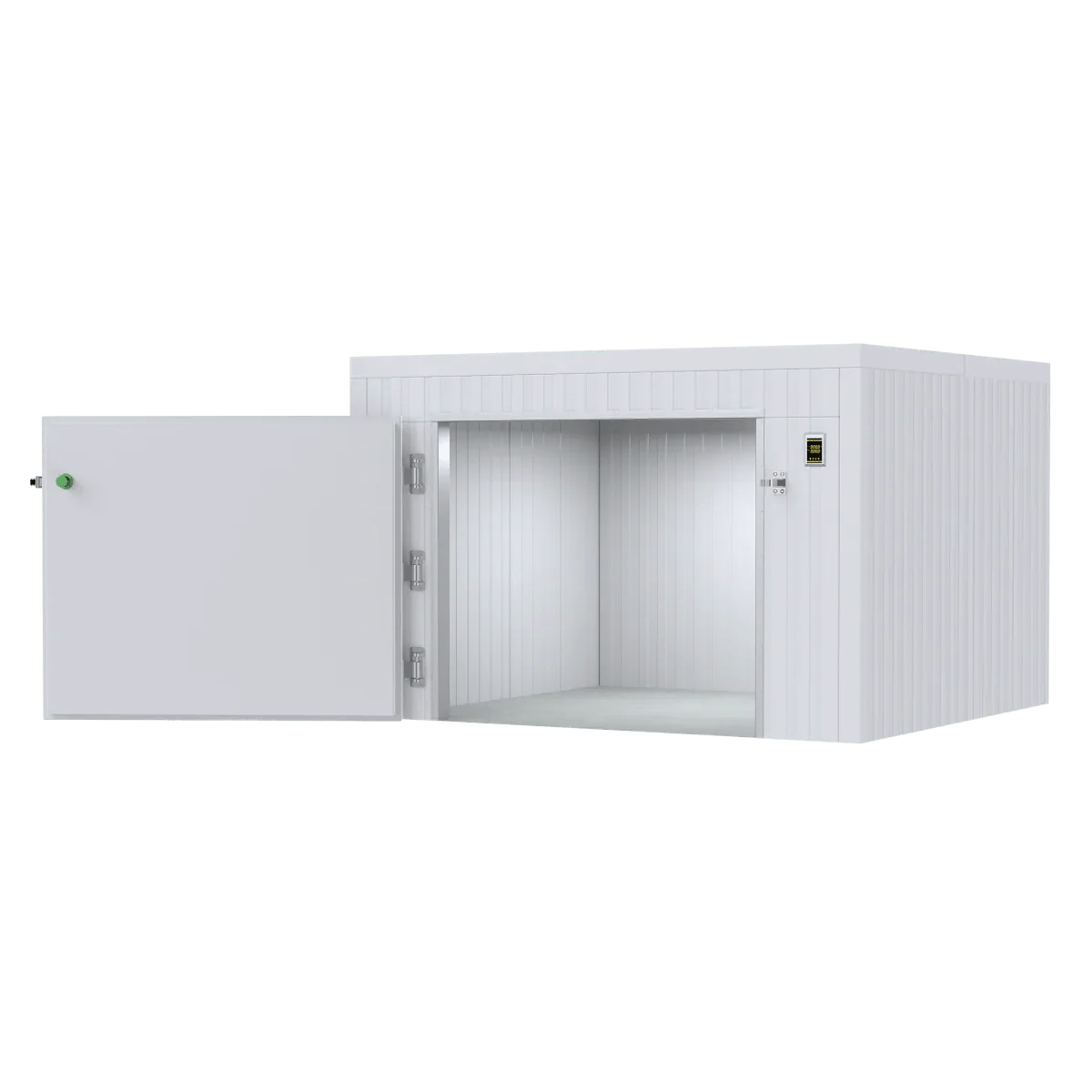Why Mortuary Cold Chambers Are Essential for Respectful End-of-Life Care
A mortuary cold chamber is a specialized refrigeration system designed to preserve human remains at controlled temperatures, typically between 2°C and 5°C (36°F to 41°F). These chambers slow decomposition, maintain dignity, and provide families the time they need to make funeral arrangements while ensuring compliance with health and safety regulations.
Quick Reference for Mortuary Cold Chambers:
- Primary Purpose: Preserve human remains and slow decomposition
- Standard Temperature: 2°C to 5°C (36°F to 41°F) for regular storage
- Ultra-Low Options: -10°C to -50°C (-14°F to -58°F) for forensic cases
- Common Capacities: Single body to 20+ bodies in modular configurations
- Key Materials: Stainless steel construction with 100mm polyurethane insulation
- Storage Duration: Few hours to several weeks depending on requirements
Mortuary cold chambers serve funeral homes, hospitals, medical examiner facilities, and forensic institutes. They differ from standard refrigerators through specialized features like individual temperature controls, hygienic stainless steel surfaces, secure locking systems, and compliance with strict health regulations.
The importance of proper temperature control cannot be overstated. At room temperature, bacterial decomposition accelerates rapidly, but controlled cooling at 2°C to 5°C significantly slows this process. For forensic investigations requiring longer preservation, ultra-low temperature chambers operating at -10°C to -50°C can virtually halt decomposition entirely.
About the Author
I'm Mortuary Cooler, a national-level mortuary cold chamber supplier with extensive experience helping funeral homes and medical facilities select the right preservation solutions. My expertise in mortuary cold chamber technology spans capacity planning, regulatory compliance, and custom installations nationwide.
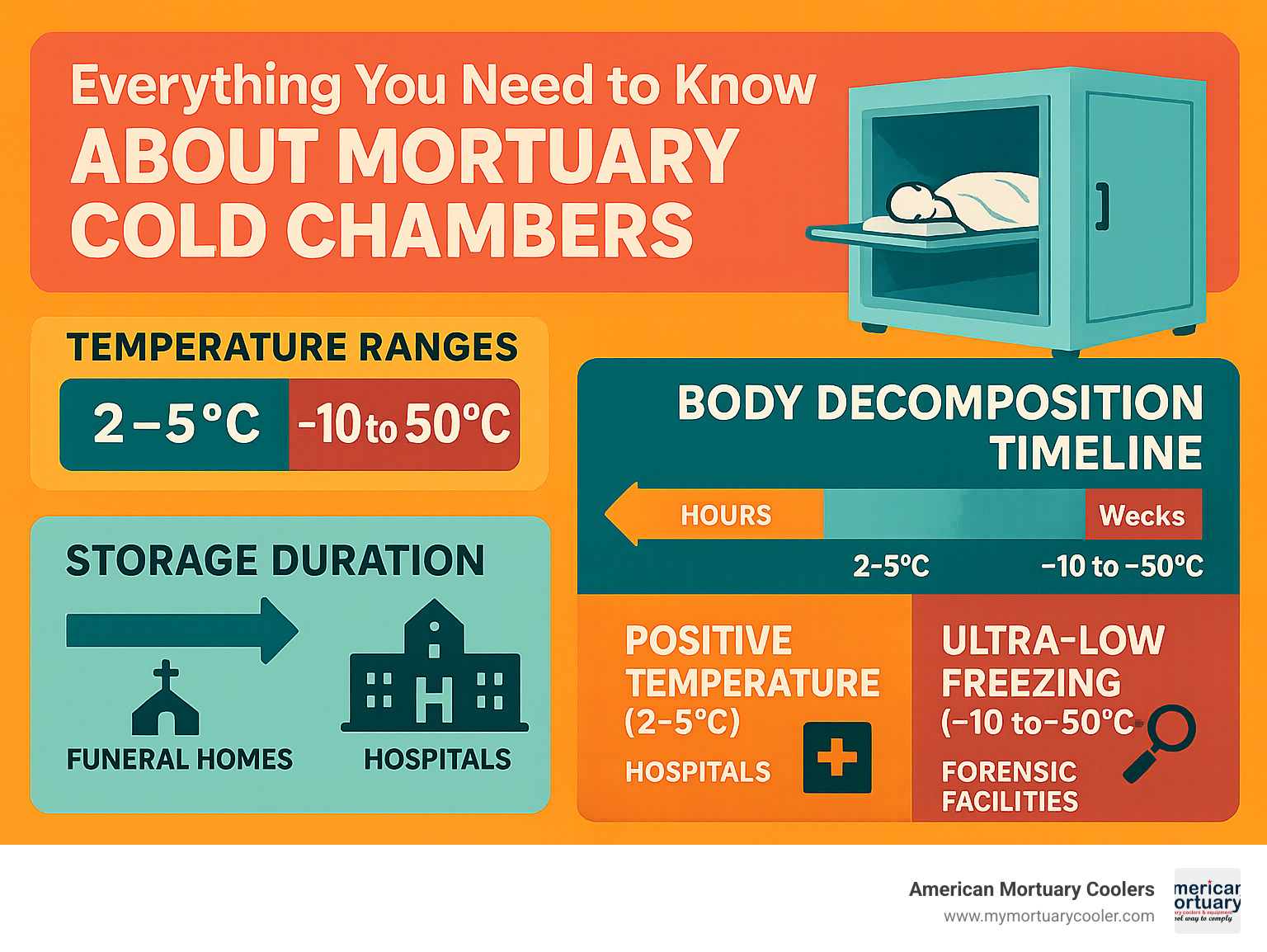
Mortuary cold chamber terms to know:
What Is a Mortuary Cold Chamber and Why Is It Essential?
When someone passes away, time becomes both precious and pressing. Families need space to grieve, make arrangements, and gather loved ones from far away. This is where a mortuary cold chamber becomes absolutely essential—it's not just equipment, it's a bridge between loss and healing.
The primary purpose of a mortuary cold chamber is beautifully simple: preserve human remains with dignity while giving families the time they need. These specialized systems maintain controlled temperatures that dramatically slow decomposition, allowing funeral directors to provide respectful care for days or even weeks.
At room temperature, bacterial growth accelerates rapidly after death. But when we cool remains to 2°C to 5°C, we essentially hit the pause button on decomposition. The bacteria that cause decay become sluggish, and enzymatic processes slow to a crawl.
Mortuary Cold Chamber vs. Morgue vs. Refrigerator
A morgue typically operates within hospitals or medical examiner facilities for investigative purposes—where bodies undergo identification, autopsy, and forensic examination. A mortuary, however, lives within the funeral home environment where preparation happens—embalming, restoration, and creating a peaceful appearance for family viewing.
When we talk about a standard mortuary refrigerator versus a mortuary cold chamber, we're looking at capacity and sophistication. While both maintain similar temperatures, cold chambers often accommodate multiple bodies and include advanced features like individual temperature controls and specialized racking mechanisms.
How Long Can Remains Be Stored?
In standard refrigeration conditions at 2°C to 5°C, bodies can typically be stored from a few days up to several weeks. The actual timeframe gets influenced by legal requirements, condition of the remains, temperature consistency, cultural practices, and embalming status.
Most funeral homes need storage capabilities of 3-7 days for standard operations, with extended capacity for special circumstances. While refrigeration dramatically slows decomposition, it doesn't stop it entirely. For cases requiring extended preservation—particularly in forensic applications—ultra-low temperature options become necessary.
How a Mortuary Cold Chamber Works: Temperatures, Mechanics & Hygiene
The inner workings of a mortuary cold chamber might seem complex, but understanding the basics helps you appreciate why these systems are so reliable. At the heart of every system is a compressor that circulates refrigerant through carefully designed evaporator coils with forced air circulation systems that eliminate hot spots.
Humidity control deserves special attention because it's often overlooked. Modern mortuary cold chamber systems automatically manage this delicate balance through built-in condensate management and carefully calibrated airflow patterns. Multiple sensors throughout the chamber feed information to digital controls that maintain conditions within ±1°C accuracy.
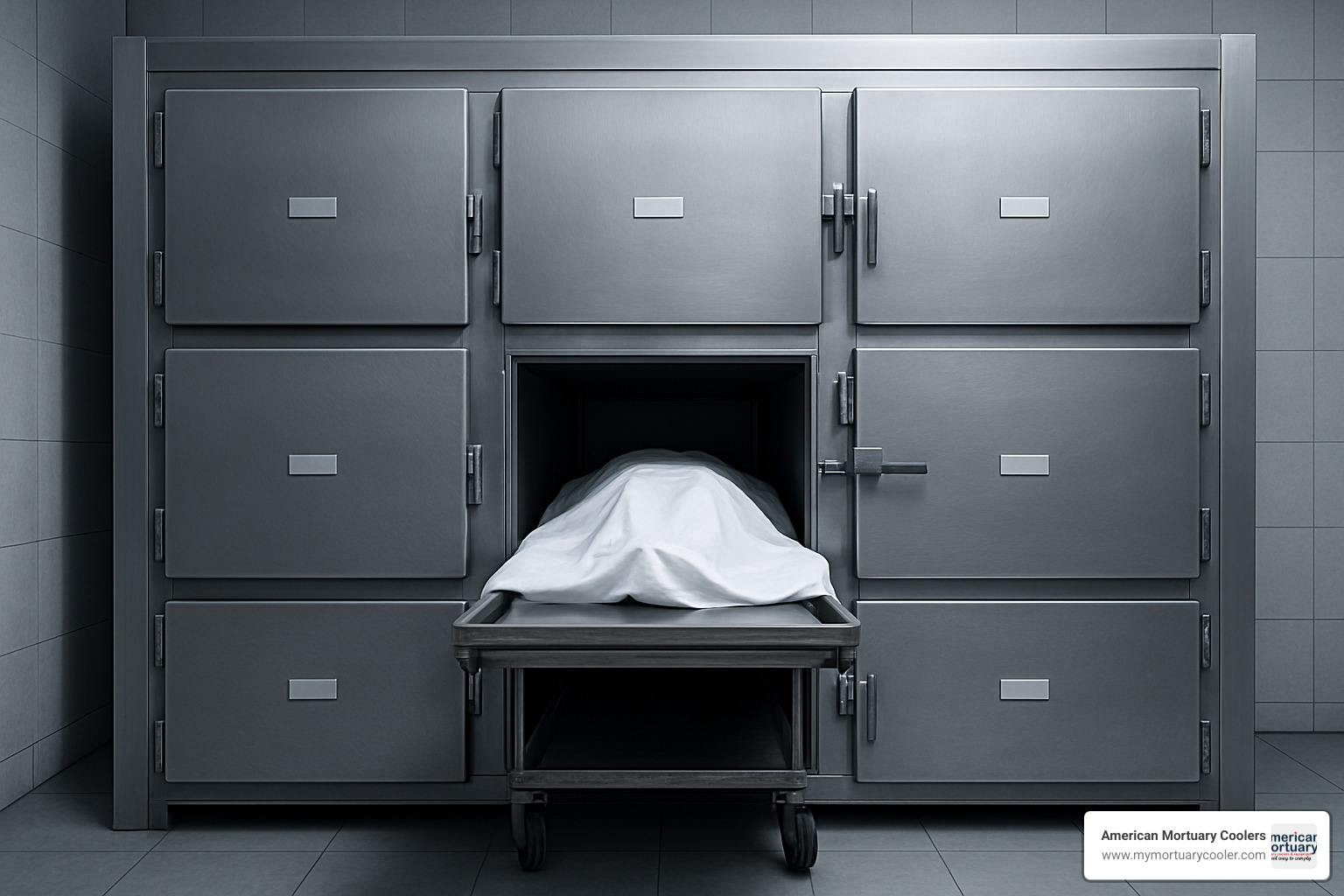
Standard Temperature Ranges (+2 °C – +5 °C)
The sweet spot for most mortuary applications sits right between 2°C and 5°C (36°F to 41°F). This range dramatically slows bacterial growth and enzymatic processes while keeping energy costs reasonable.
At these temperatures, bacterial growth slows to a crawl and harmful bacteria that cause decomposition essentially go dormant. The forensic integrity aspect is crucial too—at these temperatures, tissue samples and evidence maintain their investigative value for weeks.
Modern systems make maintaining these temperatures almost effortless through digital displays, microprocessor-based controls, and alarm systems that alert staff immediately when something goes wrong.
Ultra-Low & Freezer Modes (-10 °C – -50 °C)
Sometimes standard refrigeration isn't enough. Forensic institutes and specialized facilities need to preserve remains for months or even years, and that's where ultra-low temperature storage becomes essential. Operating between -10°C and -50°C (-14°F to -58°F), these systems essentially stop time.
The technology behind these extreme temperatures uses cascade refrigeration—essentially two refrigeration systems working together. While standard refrigeration slows decomposition, ultra-low freezing virtually halts all biological processes.
| Storage Type | Temperature Range | Typical Duration | Primary Applications |
|---|---|---|---|
| Standard Refrigeration | +2°C to +5°C | Days to weeks | Funeral homes, hospitals |
| Negative Temperature | -10°C to -20°C | Weeks to months | Extended forensic storage |
| Ultra-Low Freezing | -20°C to -50°C | Months to years | Research, mass casualties |
Types, Configurations & Capacity Planning for Mortuary Cold Chambers
Choosing the right mortuary cold chamber feels a lot like finding the perfect pair of shoes - it needs to fit your space, match your workflow, and handle whatever you throw at it. Today's systems come in configurations from compact single-body units to expansive walk-in chambers.
Single-body chambers represent the simplest approach, typically measuring around 2050×650×450 mm internally. Multi-body configurations scale up from there, with 2-body, 3-body, 6-body, and larger systems becoming increasingly popular. Walk-in mortuary cold chambers allow staff to walk right into refrigerated rooms, working well for high-volume facilities.
Modular systems use interlocking panels that arrive at your facility and get assembled on-site. They're brilliant for facilities planning future expansion—you can start with what you need today and add capacity later.
Primary Keyword Spotlight: Mortuary Cold Chamber Capacities
2-body systems hit the sweet spot for smaller funeral homes. 3-body systems often become the backbone of medium-sized funeral homes. 6-body systems earn the title of "most popular" in our installation records, providing excellent operational flexibility while fitting comfortably in most facility spaces.
9-body and larger systems serve high-volume facilities, hospitals, and medical examiner offices. 20-body and modular expansion systems cater to the largest facilities with ambitious growth plans.
Loading Systems & Racking Mechanisms
Telescopic rack systems extend up to three-quarters of their length, bringing the loading area closer to you. Roller rack mechanisms use strategically placed rollers to create nearly effortless movement. Body lifts provide height adjustment, dramatically reducing back strain for staff.
End-loading versus side-loading configurations offer different workflow advantages depending on your facility layout.
Optional Features & Customisations
Alarm systems provide peace of mind with temperature deviation alerts. Data logging capabilities automatically record operational data for regulatory compliance. Remote monitoring transforms facility management by allowing system status checks from anywhere. Security features include password-protected controls and robust locking mechanisms.
For comprehensive guidance on all your storage options, our detailed A Comprehensive Guide to Mortuary Cold Storage Options covers everything from basic refrigeration to specialized forensic preservation systems.
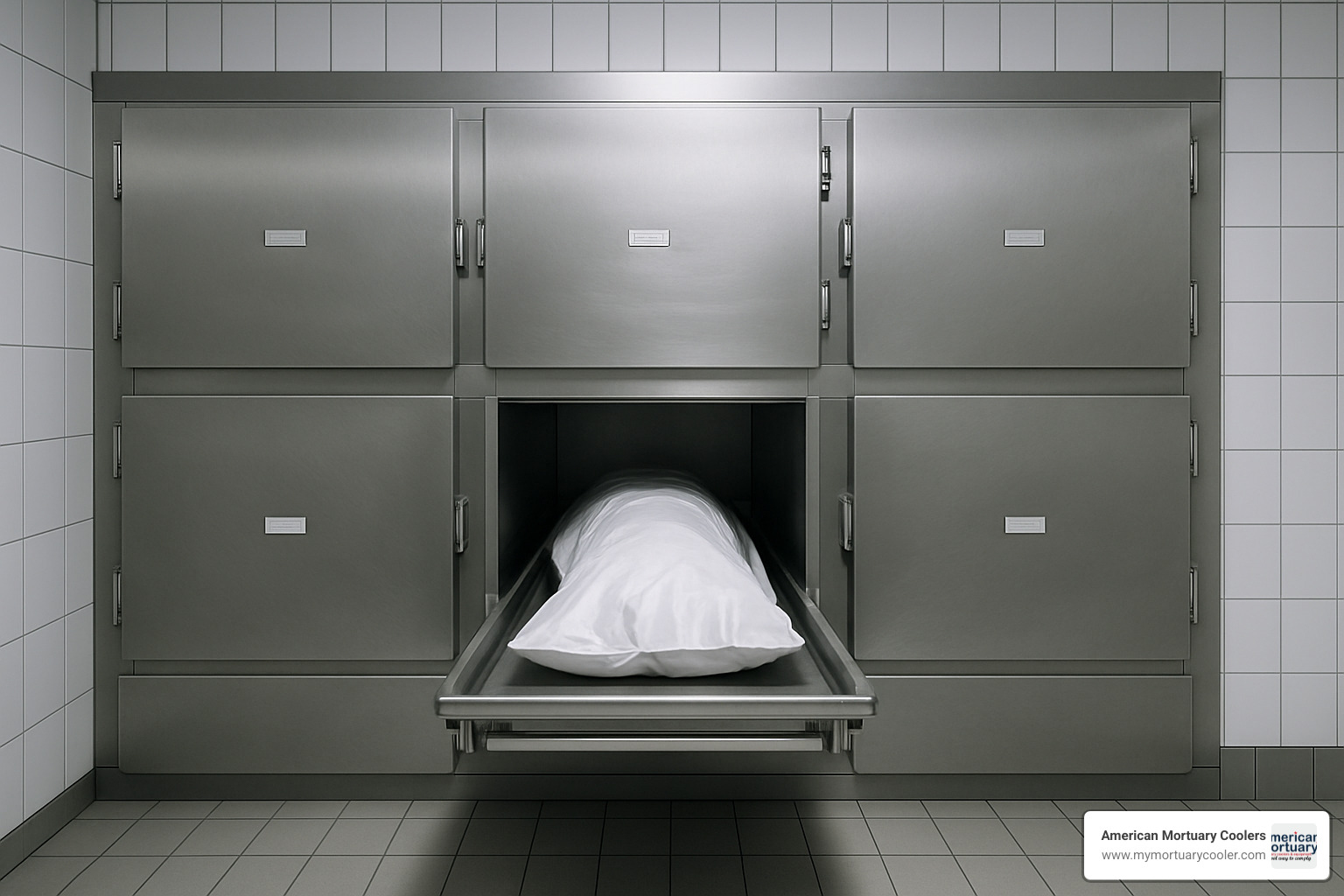
Materials, Construction & Regulatory Compliance
Building a quality mortuary cold chamber isn't just about keeping things cold—it's about creating a system that will serve families with dignity for decades to come. The materials and construction methods you choose today determine whether your investment will still be performing flawlessly years down the road.
Stainless steel construction forms the heart of every reliable mortuary cold chamber. AISI 304 grade stainless steel strikes the perfect balance between durability and cost-effectiveness, specifically chosen to resist chemicals used in mortuary operations while maintaining hygienic surfaces.
The 100mm thick polyurethane insulation at 42 kg/m³ creates a thermal barrier that keeps temperatures stable while keeping energy bills reasonable. Cam-lock panel systems have revolutionized installation with precision-engineered connections that create incredibly strong, insulated joints.
All systems use CFC-free refrigerants like R-134a that meet current environmental standards. ISO 9001:2008 certification means manufacturers have committed to consistent quality control throughout their manufacturing process.
For detailed technical information about material properties, you can reference Scientific research on corrosion-resistant stainless steel.
Ensuring Hygiene & Durability in a Mortuary Cold Chamber
Hygiene in a mortuary cold chamber goes far beyond what most people imagine. Easy-clean surfaces start with smart design choices—every interior surface needs to be smooth and seamless, with rounded corners and seamless welding throughout construction.
Floor drains and proper drainage prevent cleaning fluids and condensate from pooling inside chambers. Antimicrobial coatings provide an extra layer of protection, actively fighting bacterial growth on surfaces.
The gasket and seal design uses high-quality neoprene gaskets that resist degradation from cleaning chemicals while maintaining airtight seals.
Meeting Health, Safety & Cultural Requirements
Every mortuary cold chamber installation must steer health codes, safety regulations, and cultural sensitivities. Personal Protective Equipment zones around chambers protect public health while proper ventilation systems prevent harmful vapor buildup.
Viewing windows serve important cultural and emotional functions while maintaining controlled environments. Religious and cultural accommodations require flexibility in chamber design and operation to meet diverse community needs.
For forensic applications, chain-of-custody requirements demand detailed documentation through electronic access controls and automatic logging systems.
Selecting, Installing & Maintaining Your Mortuary Cold Chamber
Choosing the right mortuary cold chamber feels overwhelming at first, but breaking it down into manageable steps makes the process much clearer. The key is thinking beyond today's needs to where your facility will be in five to ten years.
Site planning starts with honest capacity assessment. Plan for peak periods rather than average days—it's far more cost-effective to install a slightly larger system now than to scramble for expansion later.
Electrical requirements vary significantly based on system size. Smaller units typically run on 220-230V single-phase power, while larger systems need three-phase power. Floor strength matters more than most people realize—a 6-body chamber weighs about 620 kg empty.
Ventilation serves two critical purposes: refrigeration condensers generate significant heat that must go somewhere, and proper room ventilation maintains air quality.

Design Checklist for Facility Managers
Every successful mortuary cold chamber installation starts with thorough planning. Capacity planning goes beyond simple math—consider current needs, peak capacity, seasonal variations, emergency surge capacity, and realistic growth projections.
Workflow integration determines daily operational success. Map out body receiving procedures, staff access patterns, family viewing requirements, and integration with existing operations.
Infrastructure readiness prevents installation delays. Consider electrical capacity, HVAC integration, floor loading calculations, drainage connections, and network connectivity.
For specific guidance on door options that affect workflow, review our An Essential Guide to Mortuary Cold Room Doors and Your Best Options.
Latest Innovations and Trends
IoT monitoring systems represent the biggest game-changer, tracking temperature, humidity, and system performance in real-time with cloud-based monitoring. Solar-ready refrigeration systems address rising energy costs and environmental responsibility.
Green refrigerants continue improving as environmental regulations tighten. Quick-build panel systems revolutionize installation timelines with pre-engineered components that assemble rapidly on-site.
For comprehensive industry insights, visit www.wjkenyon.com for valuable resources that complement our installation experience.
Frequently Asked Questions about Mortuary Cold Chambers
When families are dealing with loss, they often have questions about how their loved ones are being cared for. As someone who's helped countless facilities across Tennessee, Georgia, and beyond, I've heard these questions many times. Let me share the answers that matter most.
What is the ideal temperature range for body storage?
The sweet spot for mortuary cold chamber operation is 2°C to 5°C (36°F to 41°F) for everyday preservation needs. This range hits the perfect balance - it slows down bacterial growth and decomposition significantly while keeping energy costs reasonable.
Here's what I've learned from years of installations: consistency beats extremes every time. A chamber that holds steady at 4°C will preserve remains better than one that bounces between 2°C and 6°C. Your loved ones deserve that stability.
For special situations like forensic investigations that need extended preservation, we move into ultra-low temperatures of -10°C to -50°C (-14°F to -58°F). These extreme temperatures virtually stop decomposition entirely, which is crucial when investigations take months or even years.
The science is straightforward - at room temperature, bacterial decomposition happens fast. But drop that temperature into our ideal range, and those processes slow to a crawl, giving families the time they need to make arrangements with dignity.
How much space does a 6-body chamber require?
Planning space for a mortuary cold chamber involves more than just the unit itself. A typical 6-body system needs about 2.5 meters by 1.5 meters of floor space and stands roughly 2.2 meters tall. But that's just the beginning.
You'll need room to work around it. The doors need an extra 1.2 meters in front to open fully - there's nothing more frustrating than a chamber you can't access properly. Add 0.6 meters of clearance on the sides and back for maintenance access, because trust me, your technician will thank you later.
My recommendation? Plan for a 4-meter by 3-meter room minimum for a 6-body system. This gives you the working space that makes daily operations smooth and respectful.
Don't forget about weight - these units tip the scales at around 620 kilograms empty. Older buildings especially need floor strength evaluation. I've seen too many installations delayed because nobody checked if the floor could handle the load.
Can chambers accommodate specific religious practices?
Absolutely, and this is something close to my heart. Every family deserves to honor their traditions, and modern mortuary cold chamber systems are designed with this in mind.
Positioning requirements are probably the most common need we address. Whether it's specific body orientation or particular placement needs, adjustable shelving and flexible chamber designs make it possible while keeping preservation conditions perfect.
Timing considerations matter deeply to many families. Some faiths require burial within specific timeframes, while others need extended viewing periods. Our chambers maintain bodies respectfully for whatever timeline your traditions require.
Access provisions like viewing windows with specialized lighting let families see their loved ones without disrupting the controlled environment. It's a small feature that means everything to grieving families.
Cleanliness standards can be incredibly strict for certain religious practices. We've developed specialized cleaning protocols and hygiene features that meet even the most demanding requirements.
Over the years, I've worked with Islamic, Jewish, Christian, and many other religious communities across our service areas. Each installation gets customized to honor specific cultural and religious needs while keeping operations running smoothly. Because at the end of the day, it's not just about the equipment - it's about serving families with the respect and dignity they deserve.
Conclusion
Choosing the right mortuary cold chamber isn't just about refrigeration—it's about providing families with the dignity and time they need during life's most difficult moments. These specialized systems represent the intersection of advanced technology and compassionate care.
At American Mortuary Coolers, we've helped funeral homes, hospitals, and medical facilities across all 48 contiguous states find solutions that fit their unique needs and budgets. From our Tennessee headquarters, we've seen how the right preservation system transforms a facility's ability to serve its community.
Modern mortuary cold chambers offer remarkable adaptability, from compact 2-body units to 20-body modular systems. The technology keeps improving with IoT monitoring, energy-efficient designs, and smart alarms that provide peace of mind without constant false alerts.
Successful installations start with understanding each facility's unique workflow. The investment in quality mortuary refrigeration pays for itself through reliable operation, lower energy costs, and fewer emergency service calls. More importantly, it gives you confidence that your facility can provide proper care regardless of circumstances.
For detailed guidance on selecting the right system, our The Complete Guide to Mortuary Coolers and Requirements covers everything from capacity planning to regulatory compliance.
The families you serve depend on your facility's ability to provide proper care during their time of greatest need. A quality mortuary cold chamber ensures you can meet that responsibility with confidence, knowing your equipment will perform reliably when it matters most.
Ready to explore your options? Contact American Mortuary Coolers today to discuss your specific requirements. We'll help you design a system that serves your community with the reliability, efficiency, and respect they deserve.


















